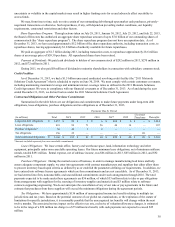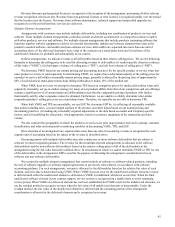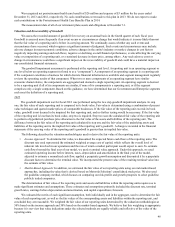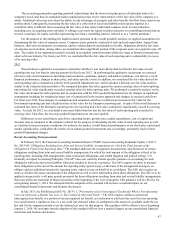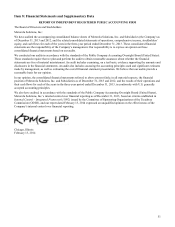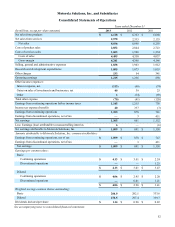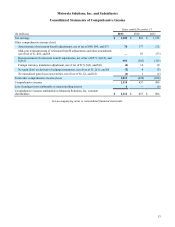Motorola 2013 Annual Report Download - page 46
Download and view the complete annual report
Please find page 46 of the 2013 Motorola annual report below. You can navigate through the pages in the report by either clicking on the pages listed below, or by using the keyword search tool below to find specific information within the annual report.44
planning strategies that are prudent and can be reasonably implemented. Based on our assessment, we recorded $274 million
of tax benefit related to the reversal of a valuation allowance established on U.S. deferred tax assets in 2011. The U.S.
valuation allowance as of December 31, 2013 relates to state tax carryforwards that we expect to expire unutilized.
We have a total deferred tax asset valuation allowance of approximately $256 million against gross deferred tax assets of
approximately $4.1 billion as of December 31, 2013, compared to total deferred tax asset valuation allowance of approximately
$308 million against net deferred tax assets of approximately $4.7 billion as of December 31, 2012.
Restructuring Activities
We maintain a formal Involuntary Severance Plan (the “Severance Plan”), which permits us to offer eligible employees
severance benefits based on years of service and employment grade level in the event that employment is involuntarily
terminated as a result of a reduction-in-force or restructuring. The Severance Plan includes defined formulas to calculate
employees’ termination benefits. In addition to the Involuntary Severance Plan, during the year ended December 31, 2013, we
accepted voluntary applications to our Severance Plan from a defined subset of employees within the United States. Voluntary
applicants received termination benefits based on the formulas defined in the Severance Plan; however, termination benefits,
which are normally capped at six months of salary, were capped at a full year’s salary.
We recognize termination benefits based on formulas per the Severance Plan at the point in time that future settlement is
probable and can be reasonably estimated based on estimates prepared at the time a restructuring plan is approved by
management. Exit costs consist of future minimum lease payments on vacated facilities and other contractual terminations. At
each reporting date, we evaluate our accruals for employee separation and exit costs to ensure the accruals are still appropriate.
In certain circumstances, accruals are no longer needed because of efficiencies in carrying out the plans or because employees
previously identified for separation resigned from the Company and did not receive severance, or were redeployed due to
circumstances not foreseen when the original plans were approved. In these cases, we reverse accruals through the consolidated
statements of operations where the original charges were recorded when it is determined they are no longer needed.
Retirement Benefits
Our noncontributory pension plan (the “Regular Pension Plan”) covers U.S. employees who became eligible after one
year of service. The benefit formula is dependent upon employee earnings and years of service. Effective January 1, 2005,
newly-hired employees are not eligible to participate in the Regular Pension Plan. We also provide defined benefit plans which
cover non-U.S. employees in certain jurisdictions, principally the United Kingdom, Germany and Japan (the “Non-U.S.
Plans”). Other pension plans outside of the U.S. are not material to us either individually or in the aggregate.
We also had a noncontributory supplemental retirement benefit plan (the “Officers’ Plan”) for our elected officers. The
Officers’ Plan contained provisions for vesting and funding the participants’ expected retirement benefits when the participants
met the minimum age and years of service requirements. During 2013, the Officers' Plan was settled and terminated.
We have an additional noncontributory supplemental retirement benefit plan, the Motorola Supplemental Pension Plan
(“MSPP”), which provides supplemental benefits to individuals by replacing the Regular Pension Plan benefits that are lost by
such individuals under the retirement formula due to application of the limitations imposed by the Internal Revenue Code.
However, elected officers who were covered under the Officers’ Plan were not eligible to participate in the MSPP. Effective
January 1, 2007, eligible compensation was capped at the IRS limit plus $175,000 (the “Cap”) or, for those already in excess of
the Cap as of January 1, 2007, the eligible compensation used to compute such employee’s MSPP benefit for all future years is
the greater of: (i) such employee’s eligible compensation as of January 1, 2007 (frozen at that amount) or (ii) the relevant Cap
for the given year. Additionally, effective January 1, 2009, the MSPP was frozen to new participants unless such participation
was required under a prior contractual entitlement.
In February 2007, we amended the Regular Pension Plan and the MSPP, modifying the definition of average earnings.
For years ended prior to December 31, 2007, benefits were calculated using the rolling average of the highest annual earnings
in any five years within the previous ten calendar year period. Beginning in January 2008, the benefit calculation was based on
the set of the five highest years of earnings within the ten calendar years prior to December 31, 2007, averaged with earnings
from each year after 2007. Also effective January 2008, we amended the Regular Pension Plan, modifying the vesting period
from five years to three years.
In December 2008, we amended the Regular Pension Plan, the Officers’ Plan and the MSPP (collectively, the “U.S.
Pension Benefit Plans”) such that, effective March 1, 2009: (i) no participant shall accrue any benefit or additional benefit on or
after March 1, 2009, and (ii) no compensation increases earned by a participant on or after March 1, 2009 shall be used to
compute any accrued benefit.
Certain health care benefits are available to eligible domestic employees meeting certain age and service requirements
upon termination of employment (the “Postretirement Health Care Benefits Plan”). For eligible employees hired prior to
January 1, 2002, we offset a portion of the postretirement medical costs to the retired participant. Employees hired on or after






